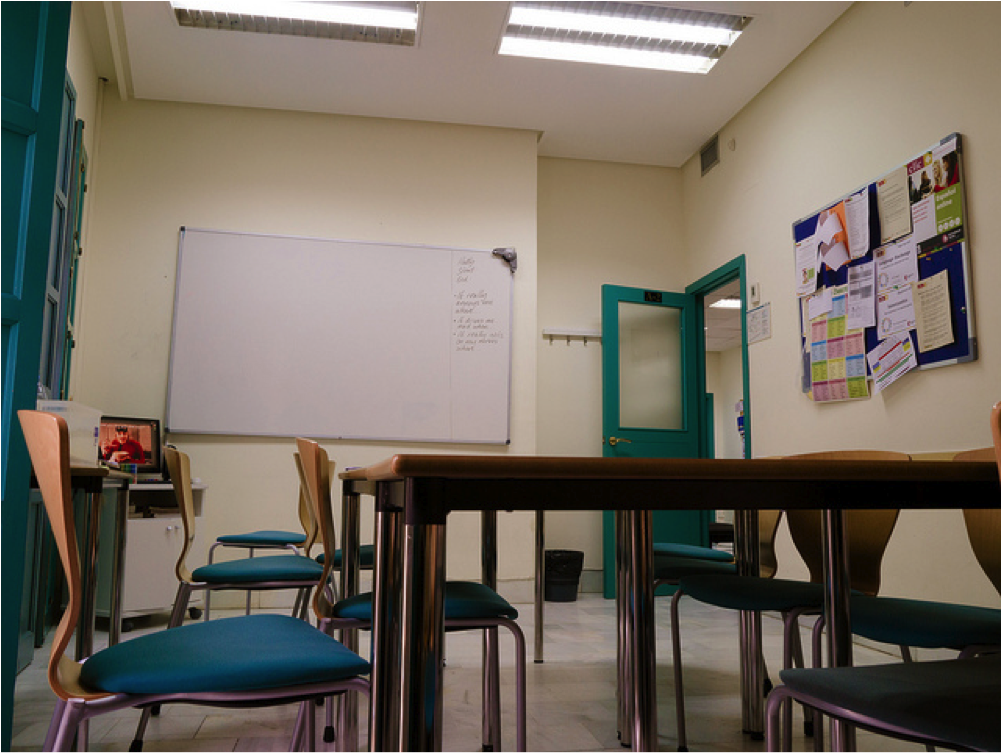Seeing Beyond The Classroom Walls — Chiew Pang
When I was asked to contribute to this topic,
one of the first things I did was to put feelers out to my PLN (Personal Learning Network).
I asked them, “What do you see each time you walk into your classroom?”

I’d like to share their comments with you.
Michael Griffin @michaelegriffin: I see an empty room that will soon be filled with humans and possibilities.
Jo McN @cunningcanis: I see community spirit.
Yitzha Sarwono @yitzha_sarwono: I see smiles and laughter painted on each wall.
Anne Hendler @AnneHendler: I see the potential to turn the room into anything we want today.
Christopher Wilson @MrChrisJWilson: I see a space that wants to be filled. Anything could fill it: my voice, their voice, handouts, pictures…
Abby Popowich @abbypopowich: … an opportunity to help somebody!
@JohnPfordresher: …vast but reluctant potential
Generally, they were all very positive comments except, perhaps, for John, who qualified “potential” with “reluctant”.
Now, what do you see? Do you see your students as a reluctant potential, too? What do you really see when you walk into your classroom? Do you have a preconceived idea before you walk in? Or do you try to empty your mind, or alternatively, fill it with unrealistic over-optimistic thoughts of how you want the classroom to be? Or, perhaps, you have nothing in your mind but the plan you had prepared and a determined effort to see it through. Or, maybe even, you have hardly anything prepared, and you walk in with nothing but your experience, and have the intention only to play it by ear.
Well, do you know what you see? I’m willing to bet that the majority of us see different things at different times; after all, we are humans and we are affected by many factors, often beyond our control. That is OK. What is important, however, is that we try to be positive. We try to see the goodness, rather than the opposite, in our students. They are humans, too. They, regardless of their age, have their stories to tell; they have their experiences to bring into the class; they have their ups and downs, just like you and me.
It is more usual than not that there is always one, or a few, “bad eggs” ready to cause turmoil, ready to push you to your limits. But, do you know them? I mean know them? Do you ever talk to them, find out what their story is, what their life is really like when they leave the classroom door?
Next time you walk into your classroom, before you say anything, make eye contact with each and every one of your students. Look at them. What do you see? Do you see a life behind those eyes? Reach out to them and let yourself be reached.
What is also, maybe even more, important is this: what do you see at the end of the class? Do you try to see yourself? Do you try to see you as the students did during whatever time it was that you were in the classroom? Do you ask yourself:
What did I like about this lesson?
What didn’t I?
What did the students learn, if anything?
What would I change if I were to have this lesson again?
Learn to see not only that is visible but that which is not. Don’t be like the people Ralph Waldo Emerson saw: “People only see what they are prepared to see.”
Prepare yourself to see beyond the classroom walls.
Connect with Chiew and other iTDi Associates, Mentors, and Faculty by joining iTDi Community. Sign Up For A Free iTDi Account to create your profile and get immediate access to our social forums and trial lessons from our English For Teachers and Teacher Development courses.


Dear Chiew Pang,
It’s amazing how you’ve written such a concise insightful article on learning how to see. Indeed we need to see beyond the walls of our classroom….
Thank you for your comment and for the positive feedback. I skimmed through yours earlier, but I’ll have to reread it more calmly later.
Chiew,
I love that you not only talked about the physical space, but also about what we can see in our students. Even the ‘trouble’ ones. And, equally important is to reflect on the lesson and ourselves and try to improve on it.
Great article!
Thanks for the comment, Meghan! Great to see you here!
Dear Chiew,
Your question reminded me of the importance of thinking about both our teaching space and those who are in it. I have asked students to draw classrooms I taught in to see what they highlight and how they see the space. I have also given money to students and asked to buy furniture, etc. for a classroom. Students bought bean bags to sit on and small foam mats so they could lie down when they read. They also bought an aquarium. They bought posters of singers they liked, scenes in different countries that they were curious about.
They stacked the chairs and desks that had been in the room in one corner and covered them with a large piece of colorful cloth that a couple bought. They put my chair together with their own.
They converted my desk into a snack storage area–dried fruit in one drawer, nuts in another, etc. And drinks and individual cups which they brought from home on the surface of the desk.
They bought a few floor lamps so that we could turn off the ceiling lights which they found quite annoying both because of the hum and the bright white color.
They got wrapping paper from some stores for free and wrote on it while kneeling on the floor. They drew sketches on our board which they changed every week or so. They preferred to write on the wrapping paper on the floor to writing on the board so the board as I just said became like a kind of mural.
Re the bad eggs you mention, with the new arrangement I saw all the students in a new way. They were all able to act in different ways since the space was fluid rather than static. They could easily move the bean bags around and their mats. They wanted to buy a couple of couches as well but they were too expensive at the time.
Both your comments and the photograph of the class sparked these reflections.
John
PS I visited quite a few schools last year in a part of Japan with spectacular mountain views. The schools had huge windows on the side of each classroom. I suggested that the teachers ask the students if they would be OK if they faced the windows and could see the view rather than face the board at the front of the room every day. So on days when the view was particularly good, they turned their desks to the mountains. On days when there was a lot of mist and could see very little they were fine facing the board. The variety changed how they felt about the space.
Dear John,
Such an eye-opening comment! I long to be in that room; yes, a fluid classroom brings the best out of the students in them, doesn’t it? Can one assume that it brings the best out of the teacher, too?
Unfortunately, in real-life situations, for the majority of us, we can’t do what we like to the classroom, but there are always “little” things that can be done. I will remember, the next time I have a class to myself, to ask the students, “What would you change in this classroom?” and “Why?”. I think that would open a few more eyes.
Thanks once again, John. I’ve been very honoured to share the same “stage” with you for this series of posts 🙂
Hi Chiew,
I think your question of our preconceived notions is incredibly pertinent.
You are absolutely correct that outside circumstances can have a profound effect on how we view the classroom. I totally agree that we must maintain perspective, but also enter the classroom with a positive vision if we are to offer our students the learning environment they deserve.
Whilst working with middle school students (or any group I suppose) it can be easy to label, and I believe your post is highlights how negative thought can influence our outlook. While recognizing my students have immense potential, I also qualified it with the preconceived notion that to reach that potential I would encounter reluctance.
Thank you for reminding us that no matter the hurdles of the day to day, if we are to serve our students to the best of our ability, we must constantly strive to wipe the slate and begin anew.
John
Thanks for both your tweet & your comment, John. Of course, you’re right to mention that “reluctance” – and that reluctance can just as well be from the students as well as the teachers. The first step, as in most hurdles, is to acknowledge it. Only when we admit to yourself that the hurdle is there can we take the necessary measures to sail over it 🙂
Hi,
“People only see what they are prepared to see.” is very true. we often take things for granted . Many teachers, including myself, never try to see beyond the classroom walls. A few years ago, my students and I were working on the sample test my students had taken previously to help them find out their problems. The test contained a reading selection that told the story of a couple who read stories to their children so that they would go to asleep. The children had made a habit out of it. They would not go to bed unless one of parents read them a story. One of the students ,with the intention of mocking it out. asked if the parents were able to produce any more children once they got rid of their children ( in my culture such topics can not be discussed freely and openly). I was angry with the student’s prank. “Go and ask your mom and dad”, I said. I was being sarcastic. The student flared up and rushed out of the classroom. He went over to the principal and complained of what I had said. After the class was over, I went to the staff room. The principal wanted me to tell the whole story. I said that the student was being rude and I overreacted. I did not realize why he rushed out of the class with such indignation. The school principal said, “his father is dead”. This is why he got so angry once I directed my sarcastic remark at him.
Despite the banality, there was something about the student’s personal life I did not know. Now whenever I remember this, I still feel sorry for what happened that day.